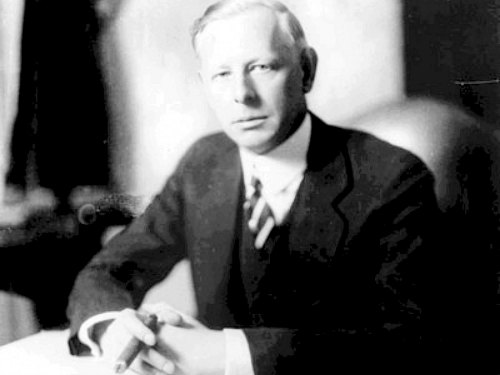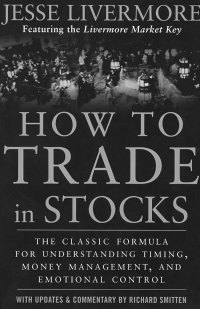You want to learn how to speculate?
Jesse Livermore is your guy.
He is one of the most methodical speculators—a real advantage in an area where adrenaline kicks in frequently.
Speculation differs from investment. Investors buy stocks looking for high-quality companies with long-term potential, while speculators only look for opportunities where significant price movements are likely (Investopedia).
As Keynes said:
“Speculation is knowing how the market will move before it does.”
So speculation is not limited to speculative stocks—stocks with a high degree of risk. Speculators look for opportunities everywhere. They are “arbitrage seekers”. Speculation includes commodities, real estate, and all kind of securities. What define a real speculator is his awareness of how much risk he takes and his expectation of high reward.
Jesse Lauriston Livermore was a gifted speculator.
Although he went bankrupt several times, he always succeeded to rebuilt million-dollar fortunes. In How to Trade in Stocks, Livermore teaches us everything he learnt from his personal experience as a trader.
Livermore was absolutely passionate about his job.
He kept track of every move he observed on the stock market. Thanks to his carefulness, he succeeded to develop principles that help us to understand how to speculate. Whether you are a risk-taker or a careful investor, reading this article will make you a better decision-maker.

Every reader of How to Trade in Stocks will be enriched by Livermore’s wisdom.
Pick up the book and you’ll learn that intelligent speculators are not basic gamblers. They are meticulous. They know the extent of the risks they take and follow strict methods and rules.
Choosing to speculate is a strategic choice. It requires a real commitment of time and energy.
How to Speculate: Lessons from a Trader
Speculating on the stock market was Livermore’s full-time job.
He spent his entire day checking how stock prices move and spotting opportunities. Throughout his impressive experience, Livermore learnt a lot. After speculating, sharing his experiences was a second passion. That’s the reason why he wrote How to Trade in Stocks.
Let’s see what he has to teach you on how to speculate:
1. Never act on tips
I repeat: Never act on tips.
Best-case scenario, your source was lucky. Worst-case scenario, you lose money and a friend. If someone is right, why would he or she share a good idea to make money?
When someone gives a tip, there are chances that he did not dare to seize this so-called opportunity. Or that he did seize it. In the latter case, the tip is already old news and you will just comfort his position. So remember: Never act on tips.
2. Speculation is hard work
Speculation is not an easy way to become rich. It is more an exciting way to do so. Indeed, as you do not make some quick money in law or surgery, you will not by speculating on the stock market.
Speculation involves effort. And it takes time.
Livermore made an interesting comparison here:
Reading How To Trade in Stocks and keeping your habits is useless if you do not follow through. It’s the same if you read a book on “how to be fit” and then wait to become fit without changing your behavior.
3. There are times when you should speculate and times when you should not
Speculating is exciting! It creates the same set of emotions than gambling. So the more you speculate, the more you want to speculate.
But stop!
It’s not always time to speculate. Sometimes, the market does not present the significant opportunities that you can seize.
If you constantly speculate, you will sometimes take a lot of risk for small rewards.
Risk is part of the game. Yet, you should only take some risk when the reward is likely to be significant.
In speculating like in life, patience is key. Although it is hard to wait for opportunities to come out, it can be really profitable.
4. Form an opinion as to what the next move of importance will be on a given stock
There is one thing that good speculators have to do well: anticipating coming movements. You need to spot triggers.
Anticipate the psychological effect of a particular piece of news on the mind of the public.
Sometimes, a piece of news will not affect the market. There is no effect because the market is either overbought or oversold.
To speculate, you have to follow three steps:
- Form a definite opinion on stocks;
- Wait until the stocks become active and confirm your opinion;
- Then back your opinion by buying or shorting.
Livermore highly recommended waiting for the market to confirm your opinion with a strong movement. It is not because you haven’t immediately acted on a move that you wont make any profits.
Why should we wait?
Livermore pointed out that we may be right on anticipating coming movements of importance. But the most difficult part is to determine when it will arrive. If we immediately buy stocks, we risk to give up if the stocks drop in price before acting as we anticipated.
So wait for the market to confirm.
5. Respect your stops
Speculators have to insure themselves against considerable losses by taking the first small loss. When you buy stocks, decide at what price level you will give up your position.
We all make mistakes, especially on the stock market.
The solution?
Putting a price limit. It guarantees to minimize losses in case we were wrong.
Sell your position when the stock price reaches because of moves that were contrary to your first opinion.
6. Develop your own guide
Although Livermore’s advice is a must-to-know, no guide can be 100% right. Recommendations mostly depend on context, personality, and time. There is no permanent truth.
It is up to you to learn from your mistakes as much as possible. And then adapt to what you learned.
How to develop your own guide on speculation:
Livermore recommended studying price movements. Keep records of price movements and take the time element into consideration.
It helps to understand how the market reacts to news, and then to anticipate coming movements of importance.
Choose different stocks on Yahoo! Finance, for example. Record news that can be related to your stocks. Then, find the correspondence between the time element and your records so as to determine major moves.
7. Learn to recognize danger signals
Spotting danger signals will help you to minimize the losses and wait for more favorable opportunities.
What is a danger signal?
Danger signals are weird movements that happen on the market. When you observe that stock prices do not move as you anticipated, look at it carefully. If you do not understand why the stock price is going downward, sell and wait for the stock to act according to your forecast.
If the stock start a downward trend, no one can say when it will stop. It is wiser to sell, rather than to wait too long and lose lots of money.

3 Don’ts of Speculation
1. Don’t sell because a stock seems too high
If the stock price seems high, do not sell without thinking carefully about it. Instead, you must decide whether the price could go higher. If you have no basis justifying an upward trend, it may be wise to sell.
Livermore recommended waiting for a danger signal. He preferred losing a bit because of a slight drop rather than missing the opportunity that the stock goes higher.
2. Don’t buy because the stock price has decreased from a previous high
When the stock price just dropped, it is likely that the price will keep its bearish trend.
If you have not anticipated this movement, do not buy more stocks. You might think it is an opportunity to buy cheaper stocks. But you will just increase the risk of losing money.
Take your loss and buy again later, when the stock prices move according to your forecast.
3. Don’t average losses
Averaging losses happens when someone who just bought some stocks keep buying, even though the stock price is declining.
For example, someone buys ten Walmart shares at $10. The day after, the stock price drops to $4 and he buys ten more. He does that because he thinks that it is the same than buying twenty shares at $7.
This strategy is bad because he lost money. When he averages losses, he is justifying that he was wrong. Instead of minimizing his loss by selling the stocks, he takes more risk speculating on stocks he cannot predict.
The Ultimate Speculation Guide
How to Trade in Stocks is a great guide for those who want to learn how to speculate. Livermore’s book is full of wise principles that you can benefit to a speculator or an investor.
At the end, everyone has their own rules.
If you want to learn more about speculating
If you want to learn either how to speculate or to be a better investor, I highly recommend the following books:
– Reminiscences of a Stock Operator: Reminiscences is a novel about Jesse Livermore and his experience as a trader. The book was published in 1923, but it still offers a lot of insights into the art of trading and speculation.
– Intelligent Investor: It’s a classic. Warren Buffett’s favourite book about investing. It teaches the philosophy of “value investing”—the opposite of speculating.
Have a good read!